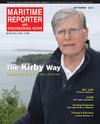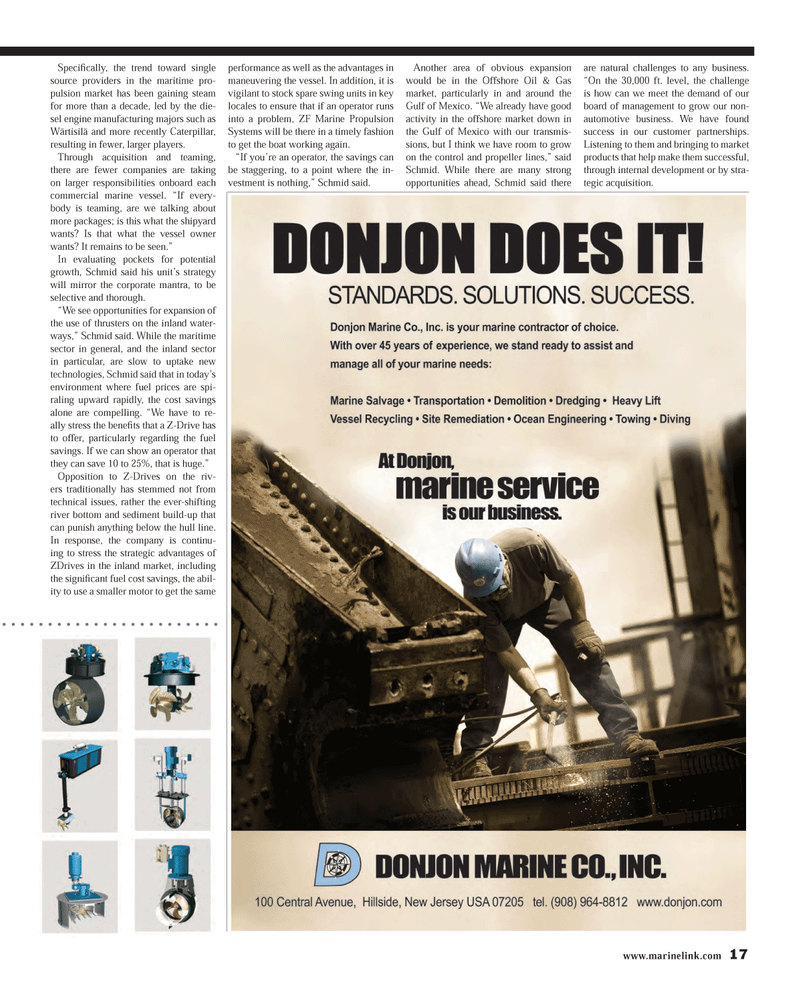
Page 17: of Maritime Reporter Magazine (September 2013)
Workboat Annual
Read this page in Pdf, Flash or Html5 edition of September 2013 Maritime Reporter Magazine
SpeciÞ cally, the trend toward single source providers in the maritime pro-pulsion market has been gaining steam for more than a decade, led by the die-sel engine manufacturing majors such as Wärtisilä and more recently Caterpillar, resulting in fewer, larger players. Through acquisition and teaming, there are fewer companies are taking on larger responsibilities onboard each commercial marine vessel. ?If every-body is teaming, are we talking about more packages; is this what the shipyard wants? Is that what the vessel owner wants? It remains to be seen.?In evaluating pockets for potential growth, Schmid said his unit?s strategy will mirror the corporate mantra, to be selective and thorough.?We see opportunities for expansion of the use of thrusters on the inland water- ways,? Schmid said. While the maritime sector in general, and the inland sector in particular, are slow to uptake new technologies, Schmid said that in today?s environment where fuel prices are spi-raling upward rapidly, the cost savings alone are compelling. ?We have to re- ally stress the beneÞ ts that a Z-Drive has to offer, particularly regarding the fuel savings. If we can show an operator that they can save 10 to 25%, that is huge.?Opposition to Z-Drives on the riv-ers traditionally has stemmed not from technical issues, rather the ever-shifting river bottom and sediment build-up that can punish anything below the hull line. In response, the company is continu-ing to stress the strategic advantages of ZDrives in the inland market, including the signiÞ cant fuel cost savings, the abil- ity to use a smaller motor to get the same performance as well as the advantages in maneuvering the vessel. In addition, it is vigilant to stock spare swing units in key locales to ensure that if an operator runs into a problem, ZF Marine Propulsion Systems will be there in a timely fashion to get the boat working again.?If you?re an operator, the savings can be staggering, to a point where the in-vestment is nothing,? Schmid said. Another area of obvious expansion would be in the Offshore Oil & Gas market, particularly in and around the Gulf of Mexico. ?We already have good activity in the offshore market down in the Gulf of Mexico with our transmis-sions, but I think we have room to grow on the control and propeller lines,? said Schmid. While there are many strong opportunities ahead, Schmid said there are natural challenges to any business. ?On the 30,000 ft. level, the challenge is how can we meet the demand of our board of management to grow our non-automotive business. We have found success in our customer partnerships. Listening to them and bringing to market products that help make them successful, through internal development or by stra-tegic acquisition. www.marinelink.com 17MR #9 (10-17).indd 17MR #9 (10-17).indd 179/5/2013 12:00:41 PM9/5/2013 12:00:41 PM

 16
16

 18
18
